Hello Readers,
For years, I’ve had an idea to show you pictures of rooms and then ask if they were decorated within the last ten years or at least 50 years ago.
The problem is that unless I do a lot of manipulating to make the new images look like old ones, you’ll be able to tell right away based on the image itself, not what it’s showing you.
However, I have another idea: to show you some genuine antique furniture pieces and some genuine fakes. haha
Now, the prevailing thinking going back as far as I can remember is that anything 100 years or older is an antique. However, don’t we need to say 150 years now? Anything after that should be considered vintage. I guess it depends on how one looks at it.
Although some antiquarians are now calling EVERYTHING vintage, some folks call something from the 1930s antique.
So, for this exercise, I will show you antique furniture from the 18th and 19th centuries.
These are the classic furniture pieces talked about frequently.
And, I will show you its counterpart that was made within the last 30 years or so.
What about the furniture that was made between 1900 and around 1990? We’ll call that vintage, and I will throw in some of those pieces too. Many pieces of furniture in the period and the late 19th century often looks the same as furniture of the period. However, unless it was created in the actual period, it is in the manner or style of the period.
But, there’s a fourth category.
The piece was created in the 18th or 19th century. However, it’s been refurbished. It might’ve been completely stripped of its original paint or stain, and then an artisan replicated the old finish with new paint.
Before you get all hot on under the collar at the thought of someone desecrating the provenance of this fine antique, it’s good to consider the condition of the piece of furniture being refinished.
If antique furniture is in terrible condition, then, of course, it needs to be properly restored.
Often, that might mean the appropriate cleaning finished off with a wax or oil to bring out the beautiful patina, which can only come with time.
So, the point is that a total sanding down to the bare wood should only be undertaken if necessary. If it’s a very old and rare piece, but someone used it as a cutting board and cleaned it with straight vinegar, the finish will be nil, and refinishing it will most likely increase its value.
However, this post is not about the intricacies of antique preservation. That’s not my domain.
Gosh, I got slammed about slipper chairs and light bulbs. I shudder to think what y’all are going to say about antiques.
Still, there are some definite classifications.
There is fine stained wood furniture.
While the techniques might be different today than they were 250 years ago, these pieces generally need to stay as is if they are very old and valuable.
Then, there are old painted pieces.
These can also be quite fine, or they can be incredibly weathered. Often, the pieces were painted over and over for hundreds of years. Then, when the furniture ceases to be painted, the various layers begin to show. And that isn’t easy to replicate unless one wants to spend hundreds of hours painting and hitting the piece with a rake and chains.
I guess one could always send the piece to an elementary school and let the kids use it as a playground toy.
Another point regarding pieces meant to mimic old finishes is the skill of the artist doing the faux aging. One tell-tale sign that a piece does not have its original painted finish is that the “wear” areas look too predictable. OR, the wear areas look ridiculously staged.
The edges don’t always wear out the most. They don’t consider the myriad of mishaps and regular wear and tear. Maybe Dad picked up his saddle, and the stirrups scraped the top as he rushed outside to herd the sheep.
However, genuinely old pieces sometimes look more like the piece was in a train wreck that caught on fire, and then someone through some paint over the burnt part and said, “That’s better.”
Still, that’s a tough sell for a “new” piece of furniture.
I feel the same way about antiquing new furniture pieces that I do about plastic surgery.
A little goes a long way. Based on many of the disasters I’ve seen in Hollywood, it seems prudent to do half as much as the doctor says is not enough. (Clearly, they don’t know how much is enough.) Less really IS more.
Okay, so I’ve been trying to think about the best way to present this to you.
If you want to play along and test yourself to see if you can tell an antique furniture piece from a reproduction, please go and get a piece of paper. Or, use a notepad on your device.
I am going to share several boards.
Most of the boards have six pieces of furniture. Each piece of antique furniture has a number. There are 45 pieces, including case pieces, dining tables, and dining chairs.
All of them are in the manner of the late 18th-early 19th century. The pieces I’m calling contemporary are still in the manner of the late 18th-early 19th century but were manufactured in the last 40 years or so.
There is nothing outlandishly weird here.
However, I did not take the photos, and time prevented me from using a close-up image of all but the first three. Therefore, some of the pictures might be small or unclear enough to see some of the detail.
Laurel, where can we see the answers?
I’m not telling you yet, because you guys, as darling as you all are, won’t be able to help yourself from looking, thinking no one will know but you. That’s true.
Okay, let’s begin with the first three beautiful antique cabinets. But, wait. Are they actual antique furniture pieces, or are some not even close to being antique?
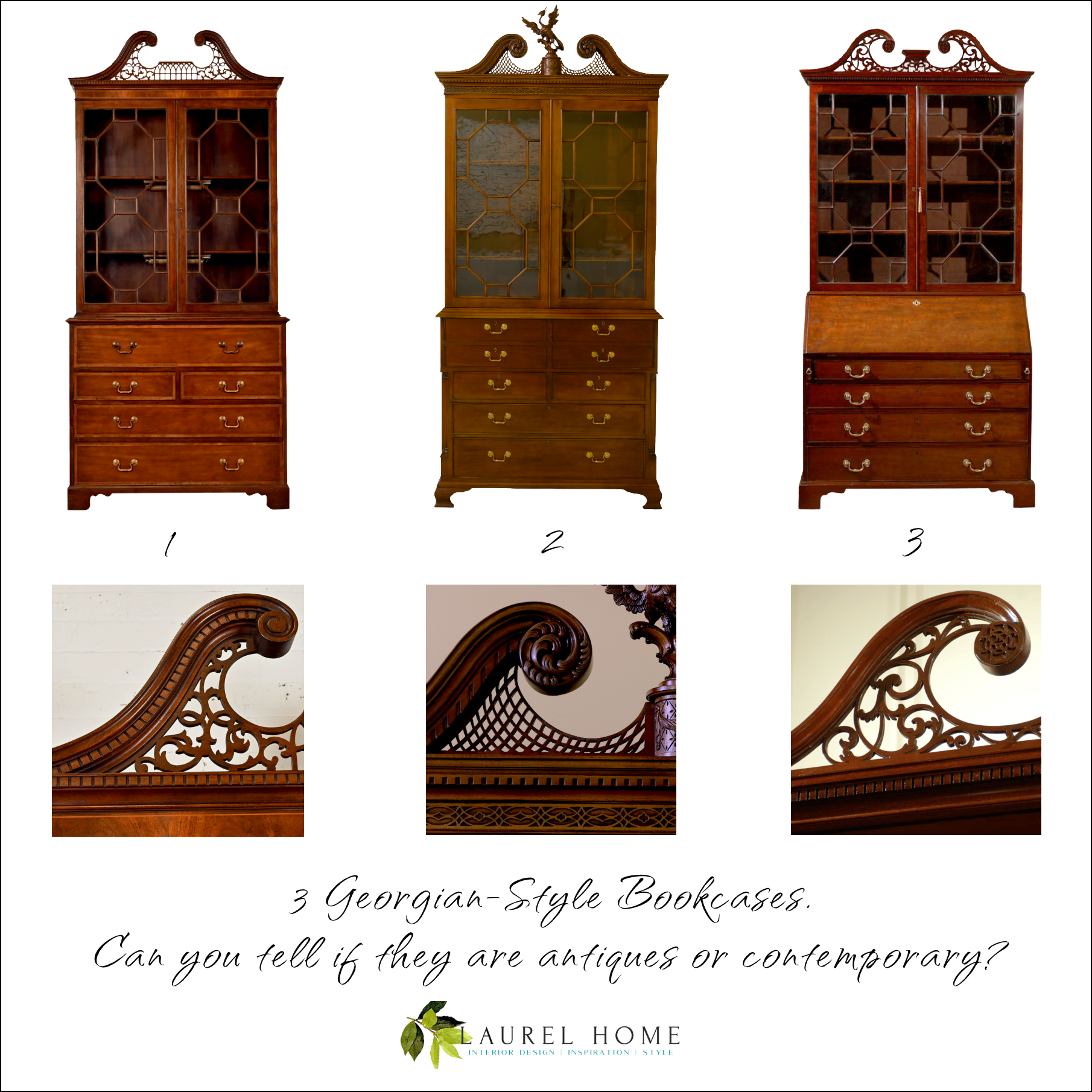
What? You thought this would be easy?
Hehe.
It’s okay; some of them are a little easier. They’re easier because it’s challenging to replicate the antiques. OR, the original pieces are pretty rare. You’ll see what I mean later on.
Please also note that some are still antiques. They’re not “of the period.”
Next up for our antique furniture challenge are six breakfronts.
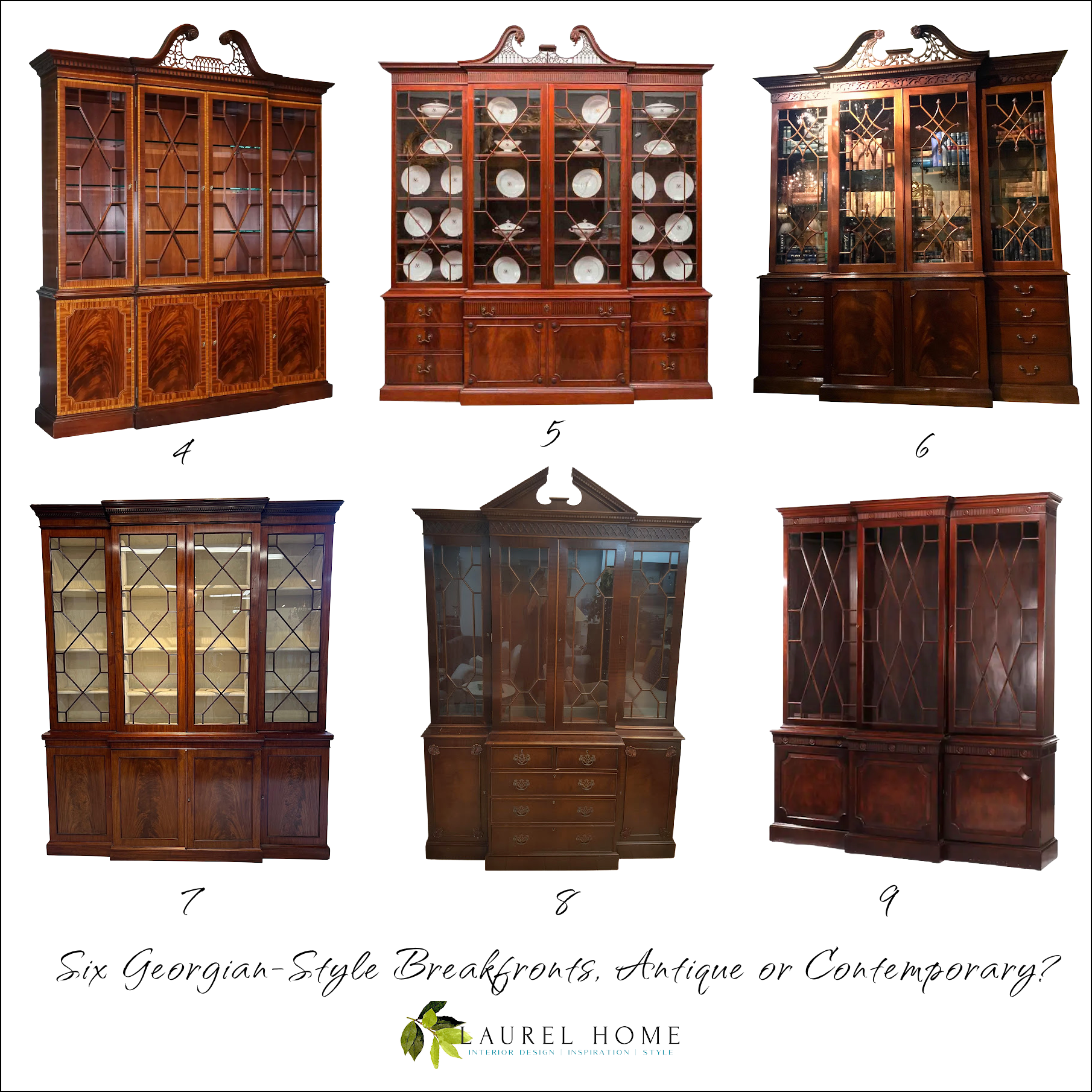
I’m breaking up the stained wood (not the breakfronts) ;] with some painted antique pieces below. These are all in the Gustavian Swedish style. But, some could also be French. Just know the numbers will be out of order.

We’ll go back to our English antique furniture pieces for buffets or sideboards.

Don’t worry if you can’t tell the difference. You’re not supposed to. That’s the sign of a super-well-done reproduction.
Let’s look at some beautiful dining tables in both the English Georgian and Gustavian styles on one board.
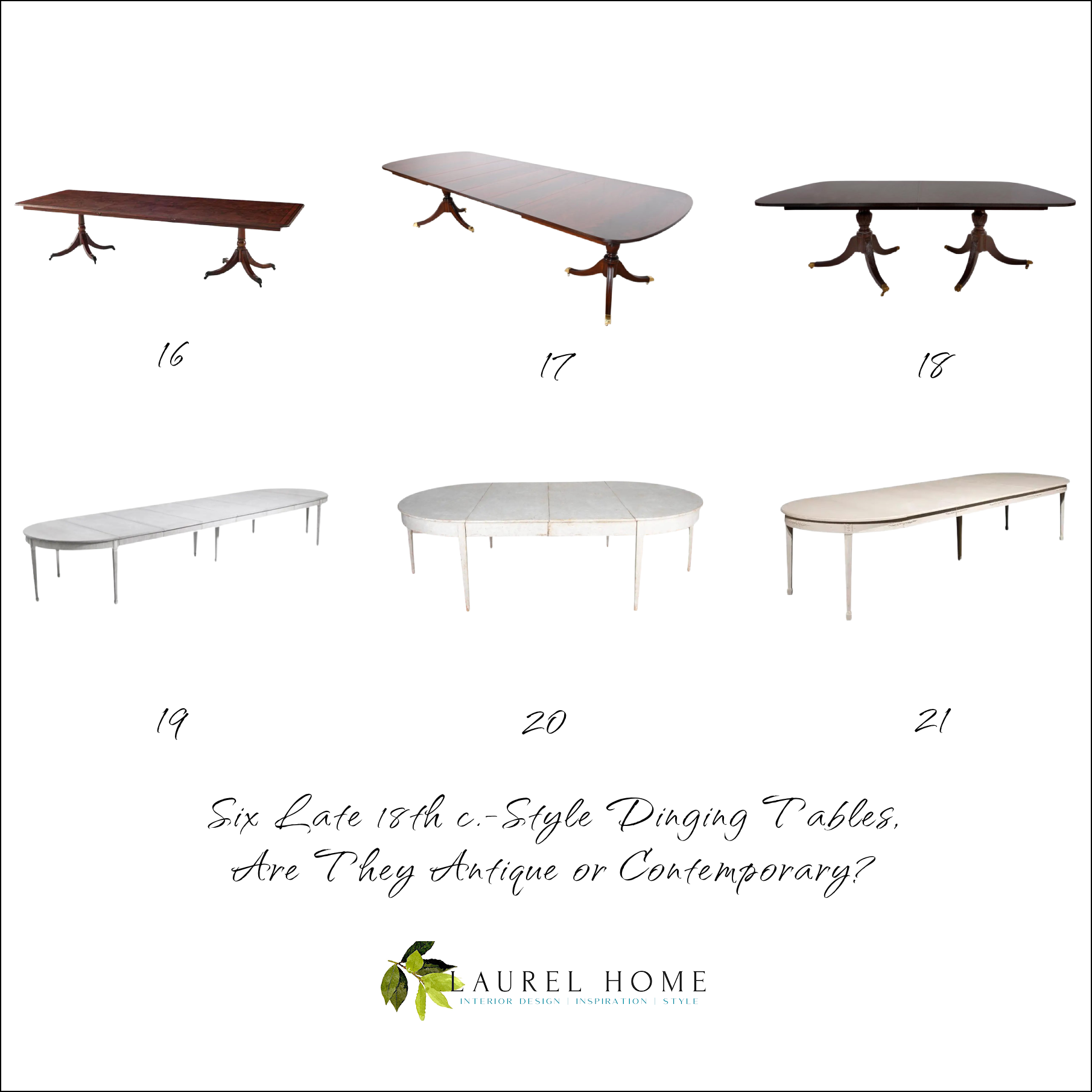
I know. This one is super tough. And remember, if you don’t get them right, it doesn’t mean you’re not knowledgeable.
I didn’t do any Chippendale or Georgian chairs because most of those are impossible to tell apart unless up close.
However, below you will find French (Louis XVI) and Gustavian chairs.
These two styles were both popular furniture styles of the late 18th century.
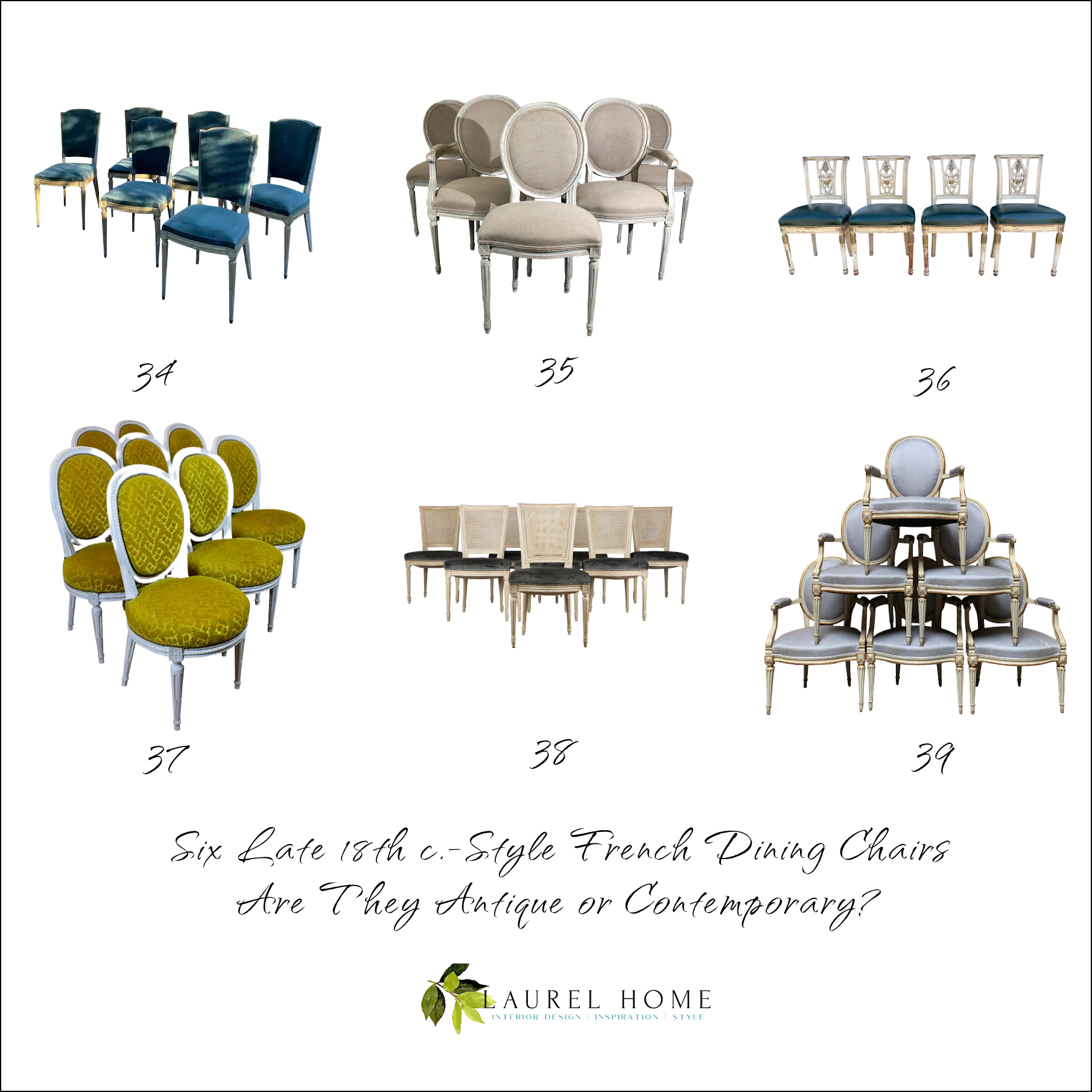
Above is the French Louis XVI style I meant to say on the board. This one is a challenge, for sure.
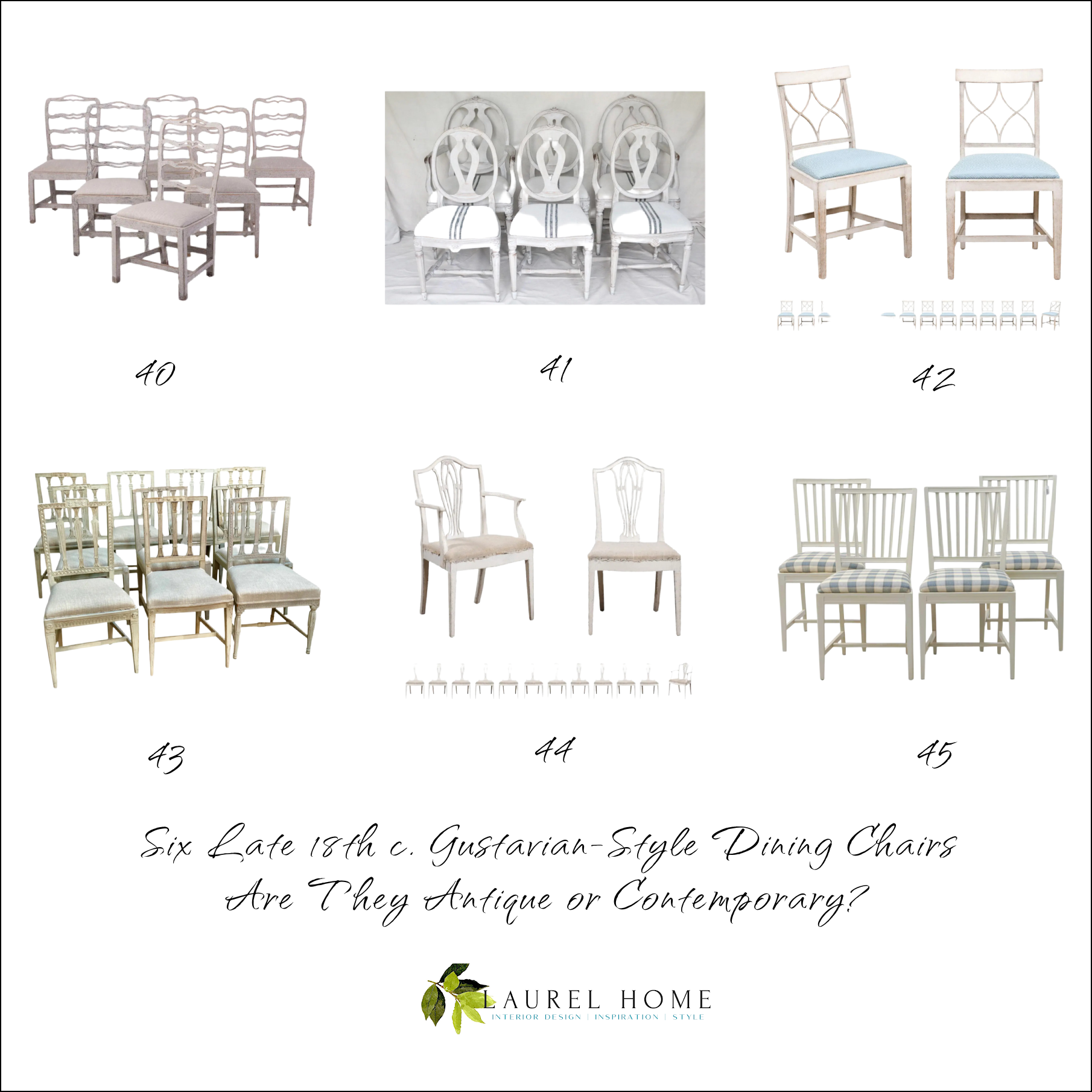
The Gustavian chairs are a little easier to tell. At least it’s easier to tell the 18th-century versions because of the irregularities in some of them.
And, the last grouping has some smaller Gustavian-Style antique furniture pieces.
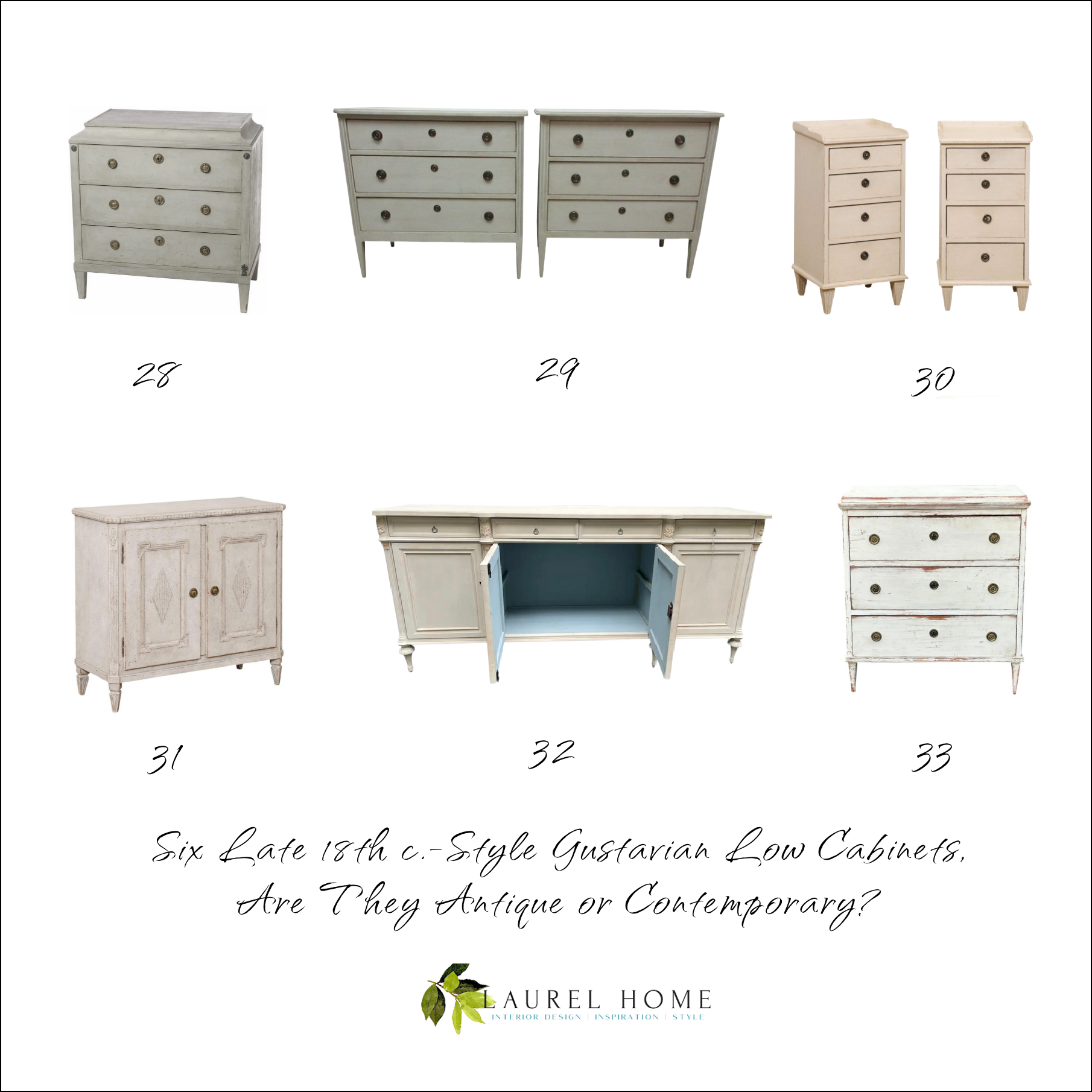
I will help you out a little on this one. If I recall correctly, there are only two pieces, that are genuinely 18th-century.
If you’d like to know the answers, I put a widget with all of the pieces on another page that you can find by clicking this link. There should be information about when the piece was created in each description, but if you want to know more about any of the pieces, you can click on the image for more information.
I hope you enjoyed this exercise.
After you’ve scored yourself, please come back and tell us how you did. Also, please tell us if you were super surprised to learn that a piece was either a bonafide 18th-century antique. Or, it was actually a contemporary piece that you would’ve sworn was 250 years old.
Speaking of which, it was just Wolfgang Mozart’s birthday on January 27th, his 267th. It’s easy for me to remember because he was born exactly 200 years and 11 days before me.
To honor my favorite composer, please visit this post for a link to the glorious Piano Concert #23, performed exquisitely by Menahem Pressler.
xo,

PS: Please check out the newly updated HOT SALES. Two huge sales are ending tomorrow, January 30th.
Related Posts
 Nine Fabulous Benjamin Moore Blue Paint Colors
Nine Fabulous Benjamin Moore Blue Paint Colors Indoor Air Pollution + Best Ways To Get Rid Of Dust & Soot
Indoor Air Pollution + Best Ways To Get Rid Of Dust & Soot A Common Renovation Mess – Can it be Fixed?
A Common Renovation Mess – Can it be Fixed? Help! I Hired The Decorator From Hell
Help! I Hired The Decorator From Hell The Beacon Hill Hidden Garden Tour 2022
The Beacon Hill Hidden Garden Tour 2022 Two Doctors Try To Save Man’s Eye After Dining Room Lighting Accident
Two Doctors Try To Save Man’s Eye After Dining Room Lighting Accident Gustavian Swedish Colors That Might Surprise You
Gustavian Swedish Colors That Might Surprise You









20 Responses
Hah! No time for counting, but a quick look tells me I did reasonably well! Its a creative excersize for the brain! Thanks Laurel.
I got 29 right! So much fun but I suck at the breakfronts!
What a fun exercise! I got 24 right. I checked for glass shelves on the breakfronts,I knew that had to be contemporary. The buffets and tables were a challenge.I love learning about furniture this way. Thank you so much Laurel.
(To Rory) And I mis-stated (reversed) it in my second comment, but I take you understood what I meant.
I got 25 correct, but I was considering antique as 19th century or earlier. I may have gotten a few more if that was extended as noted by a previous poster. This was an interesting quiz. 🙂
What a fun way to start a Sunday! I actually did pretty well. I missed ten (so 35 correct), and looking back over those ten, there are five that I still would have missed again. The five that most surprised me are #s 5 through 7, #16 and #31. I thought for sure #7 was a reproduction, and I thought the finish gave #31 away as a reproduction also. Now, if I only had a proper budget… sigh…
I didn’t even try because I’d have to see them in person to make an educated guess, and even then would get a lot wrong. My criterion for buying something (like my two circa 1930’s secretaries) is strictly by the emotion they invoke, and that may not be a bad thing. Your home should be all about how happy, safe, comforted and, yes, thrilled, it all makes you feel. I have to say, my 18th and 19th century (mainly) Chinese porcelain pieces have a lot to do with how I feel about my home, so for me at least something genuinely antique is a large part of the happiness I feel in my home. No apologies for the faux gustavian dining room chairs that I purchased from one of your hot sales!
Ok, I went back and read the instructions (which I totally misunderstood), so would like to retract my score! I’m not going to attempt to take and score the quiz again (particularly since I now know the answers), but I first understood the instructions to be that the only true “antiques” were those made before 1900. After reading some of the other comments, I went back and see that you said you were calling “contemporary” only those made prior to the last 40 years. Whole different game! (I do not see any way to edit or delete my previous comment.)
Fun quiz for a rainy Sunday afternoon. I did not do very well, but I am learning from you, thank you. On another note, I have bought genuine antique chairs in the past for my breakfast room and I have found that they were not able to take the abuse of a busy family with kids and all of their friends. The worst offenders were weight-challenged, extended adult family members, I wanted to scream “don’t sit there,” or “Don’t rock back on it’s legs,” but of course bit my tongue instead. Only a couple have survived, chairs not the offenders.
Laurel,
This post was fun, but my favorite part was your comment about plastic surgery. It gave me my first chuckle for the day. I got 26 of the 45 correct. I should have gotten more right but I couldn’t bring myself to call things from the 50’s antique. Those are the things that were purchased as new when I was growing up and I refuse to call myself an antique. 🙂
That was a hard quiz for sure. I got 17, which was probably blind luck. I want to mention that I think some of the answers might be unclear, at least to some people, when they only say “Gustavian (or whichever) style” with no time period. I took that to mean reproduction/contemporary, but others might take it differently.
I got 32 right, but I was paying attention to whether the piece seemed to be trying too hard to look old. I also thought about some of the carved details and whether they looked right. There’s just something about a dental detail–some of them are spaced funny–too wide–if they are more modern. I was looking for unusual wear patterns and the fabrics used on the upholstered pieces. My mother dragged me to every antiques auction, yard sale, estate sale, thrift store and resale shop in two states. It helped me develop a kind of feel for the age of a piece of furniture.
I missed a couple of pretty obvious ones, though! This test was hard, Laurel, and a lot of fun; well done!
This was challenging, but fun! I tried channeling the Keno Brothers from Antiques Roadshow, but that failed. I do know, I’d be happy with any reproduction as beautiful as these, in a much bigger house!
This was interesting and I did get a few right. I have a few pieces that are most likely early 20th century. If I’ve had something for 50 years then I think it’s an antique like me :)) The only thing that I know for sure could possibly have been built in the 1800s is a very plain very small little table with one drawer (I use it as a night stand next to a bed) that an ex husband’s grandmother said came to Montana in a covered wagon when she was a child, And she was 95 when she gave it to me 43 years ago!
This was a fun exercise for a Sunday morning—glad I’d had two cups of coffee beforehand! I was amazed to get 29 correct, though several were guesses with a 50/50 chance of getting it right. I learn SO much from your wonderful blog, thank you!
Super fun exercise! I was 28/45, failing grade, but enjoyed it all the same. I was 6/6 on the Gustovian cabinets, as they are a favorite of mine.
Thanks, Laurel! Have a great week!
How much fun! I did not participate in the chairs as I was viewing on my phone. I got at least one correct in each section except for Gustavien, which I answered correctly! Who knew? I live with a few antiques ( not my husband) most of which were my grandparents. I have my paternal grandmother’s dining chairs. They were a wedding gift and she was married in 1916. Alas they were in pieces in the barn but have been restored, diminishing the value to everyone except me! Thanks for the fun.
This was fun, but, Oh, my goodness, I have no idea! But since I’m not schooled in any of this, it’s no wonder. I’ll look forward to your explanations at a later date.
Thanks for this Laurel, both fun and educational:)! I got 24 right and was surprised with some of them. I didn’t expect to get many correct with the Chippendale Furniture correct as it’s not what I like so only got a few correct on those. I was surprised that number 37 the Louis XVI side chairs were 18th C, I think due to the reupholstering.
Interesting! I got 7 right (or 8 if I include one I hesitated over). The size of the pictures does make it difficult. I think the legs often give it away, and the nineteenth century was very good at getting the proportions subtly wrong. There’s also a limit to how big (especially long) pieces could be made in the 18th century — a bit like the mirrors because the technology was not up to making large sheets of glass.
I bought an armchair in the Friday morning brocante in my nearest town, and refurbished it myself. The wood finish was covered in water marks (a varnish restorer did the trick on that), and I stripped the upholstery. I had wondered why there was trim around the upholstery on the back; it was because the fabric was simply glued to the old fabric so the trim covered the raw edges. Beneath was yellow silk (which tore into bits when I pulled the back fabric off), and I began to wonder about the age of my piece. I re-did the upholstery with webbing across the back and some extra batting over the horsehair, and finished with grey velvet. I also started researching online, and found an antique dealer far away on the other side of France who was offering an armchair which was exactly the same as mine, down to the last detail, original Directoire, so late 18th century. I tried to buy it but couldn’t as no transporter could be found to carry it for a reasonable price. I’m now glad I didn’t get it, as it was somewhat overpriced for the fairly rustic version of Directoire that it represents, and anyway, I haven’t really got room for a second one. Mine was cheap because it has two visible repairs, so although I think it’s original, it’s not a valuable piece. But worth looking closely at a battered piece as it may be more authentic than one thinks!